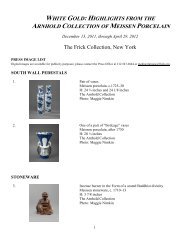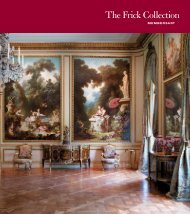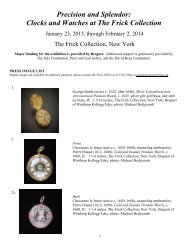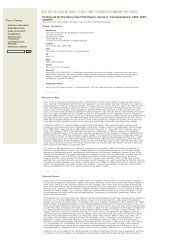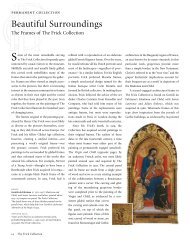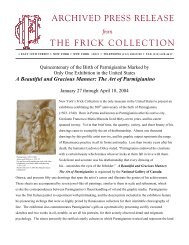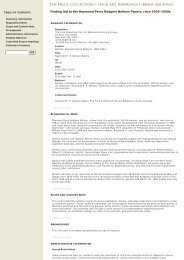Print version (PDF) - The Frick Collection
Print version (PDF) - The Frick Collection
Print version (PDF) - The Frick Collection
Create successful ePaper yourself
Turn your PDF publications into a flip-book with our unique Google optimized e-Paper software.
acquired paintings through domestic and European galleries such as Arthur Tooth & Sons, L. Crist Delmonico,<br />
<strong>The</strong> Ehrich Galleries, and Durand-Ruel & Sons. <strong>Frick</strong> also occasionally acquired works through individuals,<br />
including Virginia P. Bacon, Alice Creelman, and Roger Fry.<br />
Henry Clay <strong>Frick</strong>'s acquisitions were carefully considered, and he often kept pictures on approval in his home for<br />
months before deciding whether to purchase or return them. In certain instances, though, works of art were<br />
bought sight unseen, or brought over from Europe at his expense but not purchased. As <strong>Frick</strong>'s collection grew<br />
and his taste evolved, he sometimes returned works for credit towards another painting, and pictures were<br />
also sometimes acquired with the option to return them for full credit within a given period of time. In some<br />
cases, he actively sought the opinions of art experts such as Roger Fry, Carel F. de Wild, and Charles Henry<br />
Hart before consenting to an acquisition.<br />
Although <strong>Frick</strong> continued to acquire works of art until his death in 1919 (his last purchase was Vermeer's<br />
Mistress and Maid), he quietly established plans to open his collection to the public after his death as early as<br />
1915. In his will, dated 24 June 1915, <strong>Frick</strong> bequeathed his New York City residence, including furnishings, art,<br />
and decorative objects, as a museum "for the purpose of establishing and maintaining a gallery of art…and<br />
encouraging and developing the study of the fine arts, and of advancing the general knowledge of kindred<br />
subjects." <strong>The</strong> museum was endowed with funds for maintenance, building alterations, and acquisitions of art.<br />
Henry Clay <strong>Frick</strong>'s widow continued to live at the residence until her death in 1931. At that time, the building<br />
was extensively renovated, and opened to the public as <strong>The</strong> <strong>Frick</strong> <strong>Collection</strong> in December 1935.<br />
Sources consulted:<br />
Grier, H.D.M. "Henry Clay <strong>Frick</strong>, Art Collector," in <strong>The</strong> <strong>Frick</strong> <strong>Collection</strong>: An Illustrated Catalogue, Vol. 1, Paintings.<br />
New York: <strong>The</strong> <strong>Frick</strong> <strong>Collection</strong>; [Princeton, N.J.]: Distributed by Princeton University Press, 1968.<br />
Grier, H.D.M. Introduction to Masterpieces of <strong>The</strong> <strong>Frick</strong> <strong>Collection</strong>, by Edgar Munhall. New York: <strong>Frick</strong> <strong>Collection</strong>,<br />
1970.<br />
Ryskamp, Charles, et al. Art in the <strong>Frick</strong> <strong>Collection</strong>: Paintings, Sculpture, Decorative Arts. New York: Harry N.<br />
Abrams in association with the <strong>Frick</strong> <strong>Collection</strong>, 1996.<br />
Return to Top »<br />
SCOPE AND CONTENT<br />
Henry Clay <strong>Frick</strong>'s Art Files, 1881-1925 and undated, consist of loose correspondence, one letterpress book,<br />
invoices, vouchers, canceled checks, inventories, lists, notes, and printed material pertaining to the selection,<br />
purchase, and disposition of works of art in <strong>Frick</strong>’s collection. <strong>The</strong>se papers also document requests to visit the<br />
galleries at One East 70th Street during <strong>Frick</strong>’s lifetime, and works exhibited at institutions such as the<br />
Metropolitan Museum of Art and the Museum of Fine Arts in Boston. A small number of items date from after<br />
Henry Clay <strong>Frick</strong>’s death, and largely pertain to claims against the <strong>Frick</strong> Estate. <strong>The</strong>se files do not represent a<br />
complete record of <strong>Frick</strong>’s art collecting activities (see Related Material note above).<br />
Materials are arranged in six subseries: I. Purchases, II. Inventories and Lists, III. Catalogs and Works<br />
Exhibited, IV. Correspondence, V. Works Not Purchased, and VI. Sale Catalogs and Miscellanea. Files are<br />
arranged chronologically within each subseries.<br />
<strong>The</strong> bulk of these files are contained in the first subseries, Purchases. <strong>The</strong> amount of documentation varies<br />
greatly from one file to another, but consists largely of correspondence with dealers, invoices, canceled checks,<br />
and vouchers. Many files contain red expanding wallet envelopes with a custom-printed form on the front<br />
entitled "H.C. <strong>Frick</strong>: Paintings, Etc." <strong>The</strong>se envelopes were used by Henry Clay <strong>Frick</strong>’s office staff to house<br />
documents pertaining to his acquisitions, and on each one is noted the date of purchase, title, and artist, as<br />
well as names of correspondents, artists, other paintings mentioned in the file, the location of related material,<br />
and general remarks. <strong>The</strong>se are referred to in the container list below as “red envelopes.” It is not unusual for<br />
a file to contain only a red envelope, or purely transactional papers such as receipts and vouchers.<br />
<strong>The</strong> next two subseries, Inventories and Lists, and Catalogs and Works Exhibited, also pertain to purchased<br />
works, but provide snapshots of <strong>Frick</strong>’s collection at various periods in time. Many of the inventories and lists<br />
contained here predate the construction of One East 70th Street, and seem to have been prepared for<br />
bookkeeping purposes. <strong>The</strong>y document paintings, and to a lesser extent furniture, at <strong>Frick</strong>’s other residences,<br />
specifically “Clayton” in Pittsburgh, “Eagle Rock” in Prides Crossing, Mass., and the Vanderbilt mansion located<br />
at 640 Fifth Avenue in New York. <strong>The</strong> latter subseries, Catalogs and Works Exhibited, contains both published<br />
and unpublished descriptions of <strong>Frick</strong>’s collection, and also provides some insight into the extent to which <strong>Frick</strong><br />
allowed the public to view his collection. More information about public viewing of his gallery is contained in<br />
Subseries IV, Correspondence, which consists mostly of inquiries from individuals and groups who wished to<br />
see the collection when it was still part of a private home. This subseries also contains a letterpress book of<br />
<strong>Frick</strong>’s replies on various matters related to art collecting and the administration of his collection.<br />
Correspondents in the letterbook include Charles Carstairs of the firm M. Knoedler & Co., Henry B. Culver, Alice<br />
Creelman, Roger Fry, Martin Gardiner Lane, Ricardo de Madrazo, and H. Silva White.<br />
<strong>The</strong> last two subseries, Works Not Purchased, and Sale Catalogs and Miscellanea, mostly concern objects that<br />
never entered <strong>Frick</strong>’s collection, although some works received more serious consideration than others. Such is<br />
the case with Holbein’s Erasmus von Rotterdam and Goya’s Tirana, the files of which both contain substantially<br />
more documentation than those for works offered to <strong>Frick</strong> and directly refused. <strong>The</strong> sale catalogs contained<br />
here largely describe decorative arts objects and works on paper. With the exception of George B. Warren’s<br />
collection of miniature porcelains, which was purchased by <strong>Frick</strong> and displayed at his Massachusetts home, it<br />
has not been confirmed whether or not <strong>Frick</strong> purchased items from the other catalogs.<br />
Return to Top »<br />
ARRANGEMENT<br />
Materials are arranged in six subseries:<br />
I. Purchases, 1881-1921, undated<br />
II. Inventories and Lists, 1881-1925<br />
III. Catalogs and Works Exhibited, 1906-[1925]<br />
IV. Correspondence, 1895-1919, undated<br />
V. Works Not Purchased, 1897, 1911-1919



